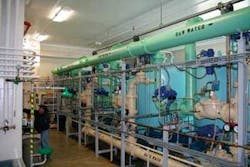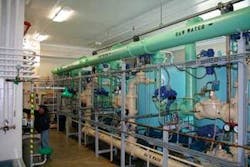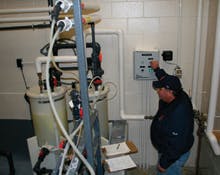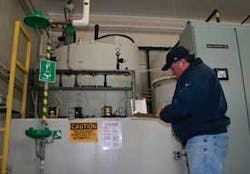First Steps to Complying with the Stage 2 DBP Rule
by Andrew Redi, Steven Sullivan and Laura Burch
One of the major innovations of the 20th century was the process by which water could be effectively and reliably purified to make it safe for drinking. This step was pivotal in eradicating the spread of diseases such as typhoid and cholera, which were once common in many cities.
However, like most arbiters of progress, safe drinking water was not without its drawbacks. For more than 100 years, chlorine was the main chemical used by municipalities to disinfect drinking water. However, in the mid 1970s, it was discovered that chlorine interacts with natural organic material common in drinking water to create potentially harmful compounds called trihalomethanes (THMs) and later haloacetic acids (HAAs). These compounds, generally referred to as disinfection byproducts (DPB), have been linked to increased risks of cancer and reproductive and developmental health defects.
In response, the U.S. Environmental Protection Agency began regulating total trihalomethanes TTHMs in 1979 and later strengthened this process by passage of the Stage 1 DBPR in 1998, which lowered the allowable TTHM level from 100 ppb to 80 ppb and also initiated regulating HAAs to 60 ppb. New standards and restrictions are being introduced constantly as new threats to public health are identified. The most recent addition is the Stage 2 Disinfectants and Disinfection Byproducts Rule (DBPR), further tightening the maximum allowable levels for total THMs (TTHMs) and HAAs to 80 ppb and 60 ppb, respectively, at a specific sampling location, rather than a collective average of all sampling points as was allowed under the Stage 1 DBPR regulations.
This new rule has put many communities using chlorine disinfectants in a bind, however, because changes made to address the Stage 2 DBPR often causes conflicts with other rules, such as the 1991 U.S. EPA Lead/Copper Rule. The rule requires municipalities to make drinking water less corrosive to pipes, generally by raising pH levels. However, raising the pH level of the water can also increase the level of DBPs in the water.
Compliance Steps
The first step in making sure your own community is in full compliance with the new amendments to the Safe Drinking Water Act is to test a sample of the treated water supply for levels of HAAs and TTHMs. This test is mandated by the U.S. EPA for public water systems (PWSs) that use a primary or secondary disinfectant, (except Ultraviolet irradiation), and can be performed either by a standard monitoring plan (SMP) process or a system specific study (SSS) process. PWSs can obtain a waiver if all DBP samples taken are below 0.040 mg/L for TTHM and 0.030 mg/L for HAA5 or if they serve less than 500 people.
Under a SMP, a specific number of sites, determined by the population size and source water type, are monitored for DBPs for one year to determine which need to be adapted to meet Stage 2 regulations. An SSS involves the development of a hydraulic model calibrated to determine the water age in the distribution system. The model must also be accompanied with one round of THM and HAA sampling. Since few systems will be able to obtain the waiver, and SSS is likely to be expensive unless the utility has already invested heavily in a hydraulic model, most utilities are likely to perform the SMP.
Once a community determines whether its water supply is close to or over the regulated levels spelled out in Stage 2 DBPR, it will need to determine the best approach for balancing these requirements with other rules, such as the Lead/Copper Rule.
There is unfortunately no one-size-fits all solution to this problem. While switching to chloramines may work in some instances, other, more extensive options such as precursor removal or alternative pre-oxidants are required. Only a thorough analysis of the unique aspects of your community’s water system can reveal the best solution.
Case Study
A seacoast community located in Southeastern Massachusetts and the fifth largest town in the state, Dartmouth’s Water Division serves 20,335 residents from 11 active wells with two new wells scheduled to come online this year. In addition, Dartmouth’s water supply is interconnected with the city of New Bedford to handle increased demand during the summer, a common practice in urban areas where quality water is scarce.
Dartmouth has performed some preliminary testing and has determined that the DPBs in its distribution system are likely to exceed the regulatory Stage 2 DPBR limits once they are implemented. One solution is for Dartmouth to switch from chlorine as the distribution disinfectant residual to chloramines, similar to the neighboring community of New Bedford. While New Bedford has already successfully implemented chloramination to meet the Stage 2 DBPR without conflict with the Lead/Copper Rule, Dartmouth was hesitant to adopt this approach as an easy way to unify the water supply. The addition of chloramines must be carefully evaluated, as they can soften the scales within pipes, which over time, can leave them vulnerable to corrosion.
Instead, Dartmouth is taking incremental steps to place the entire system in compliance with the regulations mandated by the Stage 2 DBPR. The initial step was to send lead service lines to the U.S. EPA for scale analysis to determine their sensitivity to chloramines. Preliminary tests have revealed no such sensitivity. The next step is to perform bench-scale testing on the city’s filtered water to determine if chloramines form other disinfection byproducts expected to be regulated in the next seven years.
If chloramines are determined to be the best solution (other potential solutions include alternative disinfectants or removal of the precursor material), the water treatment facility will be retrofitted with a chloramination system, with construction beginning in the fall of 2008. Funding for the water sampling will come from the Water Division’s operational budget. All other funding for the treatment plant upgrades will be through a capital improvement plan presented to the Town Meeting for the approval of funding.
“We are taking these steps to maintain a consistent water quality throughout our system, whether we are purchasing water or producing it ourselves,” said Steven Sullivan, superintendent of Dartmouth’s Water Division. “Most important, our goal is to reduce our disinfection byproducts for the good of our consumers, while maintaining compliance with other regulations mandated under the Safe Drinking Water Act - a balancing act that is common among many utilities.”
About the Authors
Andrew Reid, PE, is a Civil Engineer at Earth Tech in Concord, MA. He has been extensively involved in assisting the Town of Dartmouth in it goal of simultaneously meeting the Lead/Copper Rule and the Stage 2 DBPR. Steven Sullivan is the Superintendent of Dartmouth’s Water and Sewer Division. He has worked for the Town of Dartmouth since 1985 advancing to current position in 2001. Laura Burch is a marketing professional in the A/E/C industry. Her experience includes writing and editing proposals, technical articles, and statements of qualifications (SOQs).




